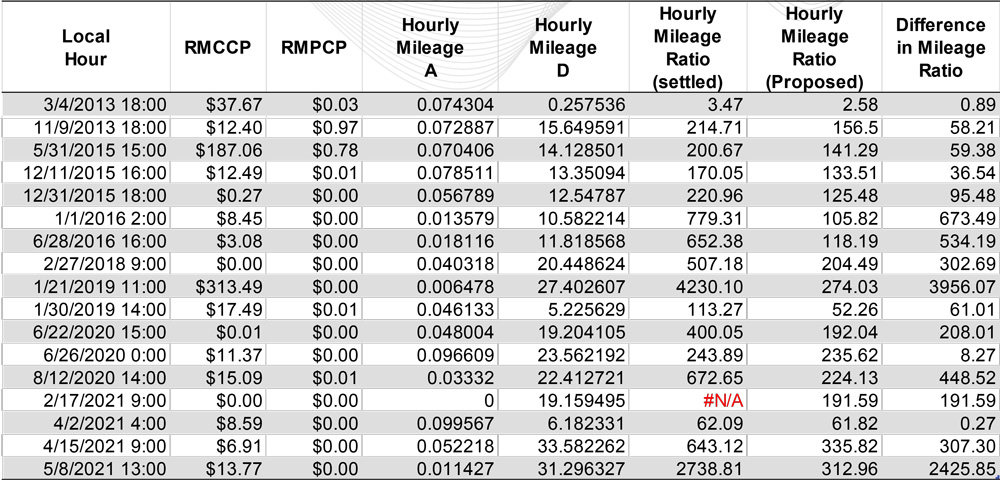Regulation Mileage Ratio Delayed
PJM stakeholders on Wednesday unanimously voted to amend the RTO’s issue charge seeking to address the calculation of regulation mileage ratio, asking for more time to discuss the issue.
Carl Johnson of the PJM Public Power Coalition requested to add a friendly amendment to the PJM proposal, amending the issue charge to remove the suggested “quick fix” process and instead handle discussions under an abbreviated consensus-based issues resolution (CBIR) process at last week’s Market Implementation Committee meeting. Johnson suggested working on the regulation mileage ratio issue over the course of two more MIC meetings and then take a stakeholder vote in October.
PJM had been seeking to work the issue through the quick-fix process in Manual 34 and take final votes at the July Operating Committee, Markets and Reliability Committee and Members Committee meetings. But several stakeholders challenged PJM’s proposed solution of updating values in the regulation mileage ratio. (See “Regulation Mileage Ratio First Read,” PJM MRC/MC Briefs: June 23, 2021.)

Johnson said the issue was too complicated to be addressed in the quick-fix process, and the impacts of PJM’s proposal were not addressed properly among stakeholders. “I don’t think this is something eligible for a quick fix,” he said.
Michael Olaleye, senior engineer with PJM’s real-time market operations, reviewed the problem statement, issue charge and RTO’s proposed solution.
Regulation mileage is the measurement of the amount of movement requested by the regulation control signal that a resource is following and is calculated for the duration of the operating hour for each regulation control signal. PJM’s performance-based regulation market splits the dispatch signal in two: RegA for slower-moving, longer-running units; and RegD for faster-responding units that operate for shorter periods, including batteries. If a signal is “pegged” high or low for an entire operating hour, the corresponding mileage would be zero for that hour.
PJM has seen increased frequency of RegA signal pegging and times the RegA signal is pegged for extended periods, Olaleye said, and the pegging highlights a potential problem in the regulation mileage ratio calculation. It can set the RegA mileage at zero for a given hour and create a divide-by-zero error in the calculation of the mileage ratio.
PJM is proposing to set the RegA mileage floor at 0.1 instead of zero, Olaleye said, which would allow for a “valid solution” for the ratio and still maintain market design objectives. He said the change would have no impact to the regulation signal design, operations or regulation market clearing.
Independent Market Monitor Joe Bowring presented a counterproposal, questioning PJM’s use of the 0.1 value. Bowring proposed a cap of 5.5 on the realized mileage ratio in all hours, indicating the cap would eliminate the current undefined mileage ratio result that PJM is attempting to address.
Bowring said the cap would reduce but not eliminate the market distortion resulting from the use of mileage ratios when they incorrectly represent regulation output. The change would affect less than 50% of impacted hours based on data collected by the Monitor over the last 15 months.
“We agree there is no magic number, but we believe 5.5 makes sense as an insurance policy against extreme cases,” Bowring said.
Gary Greiner, director of market policy for Public Service Enterprise Group, said the Monitor’s proposed cap seemed to be out of scope and impact too many hours.
Erik Heinle of the D.C. Office of the People’s Counsel said there seemed to be a “general agreement” among stakeholders that an issue exists that needs to be addressed in the regulation mileage ratio, but he said it’s “less clear” as to the potential solution. Heinle agreed with the suggestion to remove the quick-fix process from the issue charge in order to allow PJM and the Monitor to come to a possible solution on the value and for more stakeholder input.
Johnson said more stakeholder discussion would derive a better, “non-arbitrary number” to present to FERC in a filing that still fixes the ratio problem.
5-Minute Dispatch Manual Revisions
Aaron Baizman, PJM senior engineer, provided a first read of revisions to Manual 11: Energy & Ancillary Services Market Operations that would address changes and transparency to five-minute dispatch.
Members unanimously endorsed the proposed solution and associated tariff and Operating Agreement revisions at the April MRC and MC meetings. (See “Long-term 5-minute Dispatch Endorsed,” PJM MRC/MC Briefs: April 21, 2021.)
Multiple sections were updated and added in Manual 11, Baizman said, with some of the sections seeing major changes.
Baizman highlighted section 2.3.3.1: Capacity Resource Offer Rules, which includes a rule added that states hydropower capacity resources “shall meet the must-offer requirement by either self-scheduling or may allow the day-ahead market to schedule by offering the resource as a dispatchable resource.”
Section 2.5: Real-time Market Clearing Engine was “heavily edited,” Baizman said, with multiple diagrams updated and additional information added for real-time security-constrained economic dispatch (RT SCED) optimization concerning the marginal resource identification process.
Catherine Tyler of the IMM said “a lot of work” was put into the edits by PJM staff. When five-minute dispatch was first identified as an issue to tackle, she said, Manual 11 was “lacking transparency,” but the work done by PJM resulted in more transparency in the manual language.
“Not only are we improving the SCED process, but also creating a lot more transparency,” Tyler said.
Solar-battery Hybrid Resources
Stakeholders received a first look at two proposals emerging on solar-battery hybrid resources.
Scott Baker, PJM business solutions engineer, provided a summary of the solar-battery hybrid resources issue that has been worked through the DER and Inverter-based Resources Subcommittee (DIRS).
The solar-battery hybrid resources problem statement and issue charge was brought forward by PJM staff and approved by stakeholders at the June 2020 MIC meeting to clarify business rules. (See “Solar-Battery Hybrids,” PJM MIC Briefs: June 3, 2020.)
Baker said “two good packages” emerged from discussions at the DIRS and the development of the matrix. He said stakeholders in the subcommittee didn’t object to bringing two different proposals to the MIC for a first read.
Andrew Levitt of PJM’s market design and economics department provided a first read of Package A, which provides updates to the RTO’s governing documents and business manuals to clarify several aspects of market participation by solar-battery hybrid resources. It would introduce new definitions, including “mixed technology facility,” “hybrid resource,” “co-located resource” and “open-loop hybrid resource.” A “standalone energy storage resource” would be defined to draw a distinction between hybrid resources and other energy storage resources.
Levitt said the definitions are required to clarify new resource types, draw distinctions between different forms of hybrid resources and apply new or existing business rules to each resource type. For co-located resources, Levitt said, the proposal clarifies that market participation occurs separately for each underlying resource type and that metering and telemetry are required both at the point of interconnection (POI) and on one or all of the underlying resource types behind the POI.
Dominion Energy’s Jim Davis provided a first read of Package C, which was identical to Package A except for a provision pertaining to the regulation market. Package A proposes to measure regulation performance at the POI of the hybrid resource, while Package C proposes two ways:
- battery output is used to balance out intermittent renewable output, where resource response is measured at the POI meter; or
- resource response is measured independently for the battery component level using submeter output/telemetry.
Stakeholders will vote on the two proposals at the August MIC meeting.
Energy Efficiency Add-back
Monitor Bowring provided a first read of a problem statement and issue charge addressing the calculation of the energy efficiency add-back using the “quick fix” process.
Calling the problem “straightforward,” Bowring said the current treatment of the EE add-back in clearing the PJM Base Residual Auction does not require it to match the effect of EE on the capacity market’s variable resource requirement (VRR) curve. Bowring said the result of the treatment is an artificial increase in the BRA clearing price, when EE was originally designed to be neutral.
Work on the issue is expected to address the specific technical issue of the calculation of the EE add-back defined in section 2.4.5 of Manual 18: PJM Capacity Market, Bowring said, with new draft manual language to replace the section. Bowring said the manual language could be rewritten to permit PJM to calculate the EE add-back in the capacity market clearing engine so that it exactly offsets the level of cleared EE in the BRA and remains neutral.
Bowring said the quick-fix process was proposed to complete the work so that PJM can use the correct EE add-back data for the upcoming 2023/24 BRA in December.
Jeff Bastian, PJM senior consultant of market operations, said the RTO supported the Monitor’s problem statement and the objective of the proposed solution. Bastian said PJM would like to hear more details on the logic that would have to be implemented and that discussions are planned with the IMM before the next MIC meeting.
Sharon Midgley of Exelon said she believes the issue should be discussed, but she disagreed with using the quick-fix process to do it. Stakeholders would have a better understanding of what’s being changed with more discussions, she said. “There’s a lot of detail that I would like to have the group review and get comfortable with.”
Fast-start Pricing Manual Revisions
PJM introduced revisions to three different manuals addressing the implementation of fast-start pricing.
Vijay Shah, lead engineer for PJM’s real-time market operations, and Rebecca Stadelmeyer, manager of PJM’s market settlements development department, provided a first read of revisions to Manual 11: Energy & Ancillary Services Market Operations, Manual 18: PJM Capacity Market and Manual 28: Operating Agreement Accounting.
In an order issued in May, FERC accepted PJM’s filing on its fast-start tariff changes with an effective date of July 1. (See FERC Accepts PJM Fast-start Tariff Changes.) PJM filed a request to move the effective date to Sept. 1 to avoid implementation during the summer peak period, which FERC approved.
Shah said section 2.1 on Manual 11 was reorganized and includes new sections on fast-start-capable resources, fast-start-capable adjustment processes and eligible fast-start resources. The manual changes also feature new day-ahead sections, Shah said, including energy offers used in day-ahead price calculations and day-ahead integer relaxation.
The IMM’s Tyler called attention to section 4.2.9: Synchronized Reserve Market Clearing Price Calculation in Manual 11. The updated manual languages states, “In the pricing run, the cost of the marginal synchronized reserve resource may also include amortized start-up and amortized no-load costs due to integer relaxation for eligible fast-start resources.”
Tyler said the Monitor believes PJM should not be implementing fast-start pricing in this way “given this is a change that FERC didn’t ask for and PJM didn’t file Operating Agreement changes for.” She called it a “significant issue” that needs to be discussed by stakeholders.
Stadelmeyer highlighted the changes in Manual 28, including the dispatch differential lost opportunity cost credits and double counting of commitment costs. Stadelmeyer said the credits ensure resources dispatched to accommodate the “inflexibility” of fast-start resources follow PJM’s dispatch instructions to maintain power balance.
Stakeholders will vote on the manual changes at the August MIC meeting.
Manual Revisions Endorsed
The MIC endorsed changes to two different manuals as part of a periodic review:
- Manual 6: Financial Transmission Rights. The revisions included updating section 6.8 to align language with the current approach for addressing a defaulting member’s financial transmission rights with various options, versus previously with settlement only. It now goes to the MRC for a first read in July and endorsement in August.
- Manual 28: Operating Agreement Accounting. The revisions included the addition of the new section 3.10: Load Ratio Share. It now goes to the MRC for a first read in July and endorsement in August.


